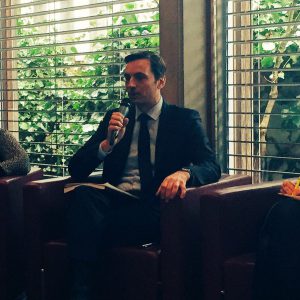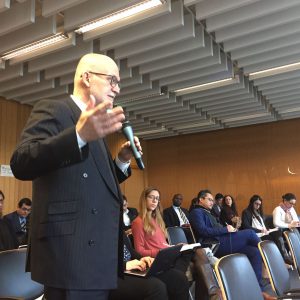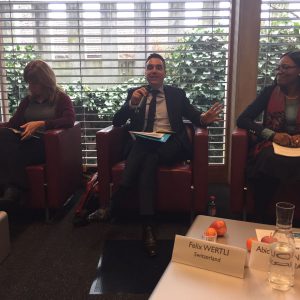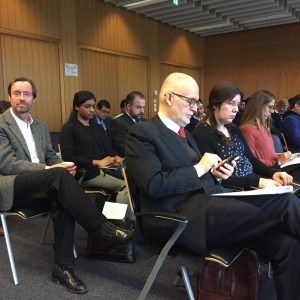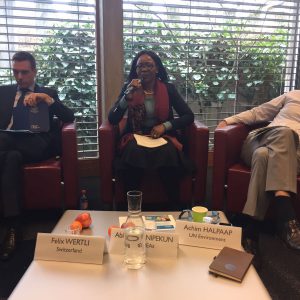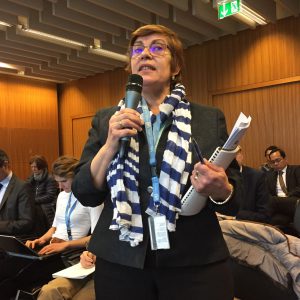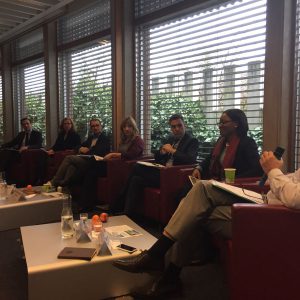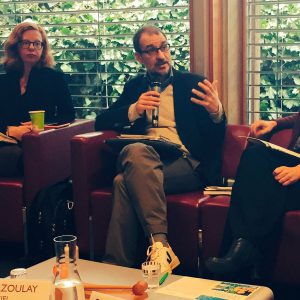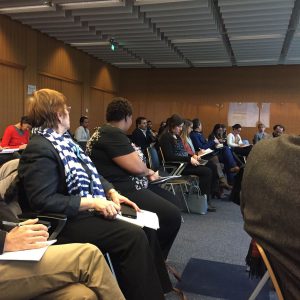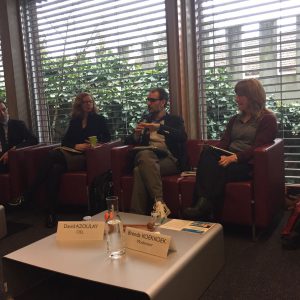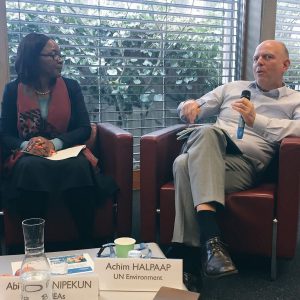Event
Bringing Sound Management of Chemicals and Waste to the Forefront of the Global Agenda
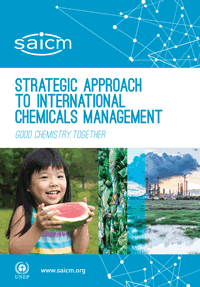
A dialogue on Bringing Sound Management of Chemicals & Waste to the Forefront of the Global Agenda, organized within the framework of the Geneva Environment Network, took place on Monday 30 January 2017, from 11am-1pm at International Environment House II.
The fourth session of the International Conference on Chemicals Management (ICCM4), held in Geneva in October 2015 decided to initiate an intersessional process to prepare recommendations regarding the Strategic Approach and sound management of chemicals and waste beyond 2020 before the fifth session of the Conference in 2020. This event took place ahead of the first meeting of the intersessional process for considering SAICM and the sound management of chemicals and waste beyond 2020, which was held in Brasilia, Brazil, from 7 to 9 February 2017, upon the invitation of the Government of Brazil.
The ICCM has called for governments and the broader stakeholder community to take part in this process, as it provides a unique opportunity to shape future policies, to nurture future partnerships and to further involve with the private sector.
The panel of this event included, among others, the participation of (alphabetical):
David AZOULAY, Environmental Health Program Director, Center for International Environmental Law (CIEL)
Andrea BROWN, Director, Sustainable Materials, World Business Council for Sustainable Development
Jacob DUER, Principal Coordinator, Interim Secretariat of the Minamata Convention and SAICM Secretariat
Odile FRANK. President, NGO Forum for Health
Achim HALPAAP, Head, Chemicals and Waste Branch, UN Environment
Abiola OLANIPEKUN, Chief, Scientific Support Branch, Secretariat of the Basel, Rotterdam, and Stockholm Conventions
Felix WERTLI, Head, Global Affairs Section, Swiss Federal Office for the Environment
Brenda KOEKKOEK, Programme Officer, SAICM Secretariat (moderator)
Summary
WELCOMING REMARKS
Brenda Koekkoek, Programme Officer at the SAICM Secretariat, welcomed all participants introduced the process to be launched in Brazil, from 7 to 9 February 2017, considering SAICM and the sound management of chemicals and waste beyond 2020. This is a unique opportunity for the chemicals and waste community to create an enhanced platform to support the implementation of the 2030 Agenda for Sustainable Development; to consider the broader pollution agenda; and to draw from experience to date in implementing the Strategic Approach.
The Strategic Approach to International Chemicals Management, or SAICM, is working towards a 2020 goal, set by the World Summit on Sustainable Development, in Johannesburg in 2002. It is an “umbrella” framework with a very broad scope, covering all industrial and agricultural chemicals, and provides an inclusive platform for action.
This event has been organized at the request of the Permanent Mission of Romania and other Permanent Missions at the last chemicals and waste briefing in November 2016. Brenda thanked the Geneva Environment Network team for their organization, as well as the Government of Switzerland for supporting to this platform, enabling multi-stakeholders to meet to discuss and prepare major environmental negotiations and emerging issues.
The goal of this event, explained Brenda, is to stimulate thinking in advance of the intersessional process considering the Strategic Approach and the sound management of chemicals and waste beyond 2020. The event started with some reflections on SAICM and the sound management of chemicals and waste. It then left place to reflexion on three specific areas for more detailed and interactive discussions.
WHAT CAN WE EXPECT FROM THE UPCOMING MEETING IN BRASILIA?
Jacob Duer, Principal Coordinator at the Interim Secretariat of the Minamata Convention and SAICM Secretariat, gave a first insight on the background of the process that will be launched in Brasilia. He explained how important it was to bear in mind that a lot has happened so far and that 2017 will be an important year for the sound management of chemicals and waste. In this regard, the fact that the sound management of chemicals and waste were integrated into the Sustainable Development Goals (SDGs) is an important recognition. Indeed, it is now a specific target under SDG 12 on Sustainable Consumption and Production. It is also referred to under SDG 3 on Good Health and Well-being and SDG 6 on Clean Water and Sanitation.
Even though the political momentum for addressing chemicals and waste has increased, efforts still need to be intensified. The meeting in Brasilia is a first opportunity to do so. It will be followed by the Meetings of the Conference of the Parties to the Basel, Rotterdam and Stockholm Conventions in April-May 2017 and by the First Conference of the Parties to the Minamata Convention on Mercury in September 2017. All are important legally binding instruments regulating chemicals and waste. As this event is taking place, the Executive Board of the World Health Organization in Geneva is meeting and discussing the role of the health sector in the sound management of chemicals, and a roadmap to be presented for adoption at the World Health Assembly in May. In parallel, UN Environment experts will take part in a meeting in Nairobi to discuss pollution in March. A lot of opportunities therefore exist and it is crucial to capitalise on those.
SAICM will be coming to an end in 2020. The upcoming meeting in Brasilia will look beyond the 2020 agenda. There is now a need to lunch a new process. Nonetheless, there is still a goal towards 2020. The next few years are important for action and all SAICM stakeholders need to take on this challenge and invest the resources required to achieve this goal. Beyond 2020, the objectives are to develop a new policy approach to addressing the sound management of chemicals and waste. All SAICM stakeholders therefore have 15 days to develop a new policy framework for chemicals and waste, as the meeting in Brazil will be initiating these discussions.
Jacob thanked Brazil for hosting this meeting and for ensuring political leadership with two ministers from Brazil, actors from the industry, members of the civil society and UN Environment– including Erik Solheim. All will be needed to start looking for a political leadership.
The meeting in Brasilia will be an opportunity for enhancing the engagement of all SAICM stakeholders; for broadening the chemicals dimension by looking at waste; and for giving a more permanent role to scientists who bring in scientific information which shapes and frames future policy frameworks. The Brasilia meeting will be followed by two others in 2018 and 2019 which will all together lead to the adoption of an approach for 2020.
Pedro Luiz Dalcero, from the Brazil Permanent Mission to the United Nations, confirmed the participations of two Brazilian the Ministry of Health and Ministry of Environment, as well as from actors of the civil society and the industry. He welcomed all participants in Brasilia next week and hoped for a very productive meeting.
Abiola Olanipekun, chief of the Scientific Support Branch at the Secretariat of the Basel, Rotterdam, and Stockholm Conventions, played a lead role in the African region in the negotiations of SAICM, in her previous position with the Government of Nigeria. She offered a view of how SAICM had impacted on the political management of chemicals and waste in Nigeria.
For the African region and for a lot of developing countries, she explained, SAICM was seen as an umbrella framework to ensure a necessary coherence for the management of chemicals and waste. It was a tool to integrate the issues of sound management of chemicals and waste onto the political agenda. Before SAICM in Nigeria, there was a lot of conflict and fragmentation in laws and policies. Stakeholders did not have a platform for discussion, making loopholes and inefficiencies very frequent. It was a very big struggle to get this agenda in motion. However, with SAICM, we had a complete overhaul. It had impact both on the technical and on the highest political level, effectively involving ministers. When it was adopted in 2006 for the first time the sound management of chemicals and waste was budgeted for at national level. The Government started recognising it not only in the framework of environmental issues, but started seeing the management of chemicals and waste as a key component of sustainable development. Key ministries – such as environment and health – finally ended up collaborating on this issue, they signed a memorandum of understanding and created a national plan. The level of engagement was very important.
Felix Wertli, Head of the Global Affairs Section at the Swiss Federal Office for the Environment, spoke about the challenges ahead. He offered his views regarding the main impacts of the Strategic Approach, and what he saw as the biggest opportunities and challenges in moving forward. The Swiss have always provided much support to the Chemicals and waste agenda. The 2020 goal is ambitious, but also realistic, he first said. It was defined for a certain moment, but as technologies change, we need to constantly adapt and minimise effects of chemicals and waste on our health and the environment. It was differently phrased in the SDG objectives, which spoke about the importance to “minimise adverse impacts”, while the 2020 goal speaks about how to “minimise significant adverse impacts”. We can thus wonder if it means that we have to broaden the focus.
Both developing and developed countries can be of support. The SAICM approach has to be both flexible and broad, and to start where the needs are, as well as on emerging issues. In Switzerland we have started dialogue with Lichtenstein, Germany and Austria to benchmark this important topic.
As the goal is not that high, it is important to look at the progress we are making by measuring the impact of what we are achieving. We need to provide insights and inputs and to focus on emerging issues.
Brenda announced that the Bureau of the Conference, SAICM guiding body, had developed a Thought Starter – Meeting Document 4 – to support initial discussions at the intersessional meeting. It will be available on SAICM’s website. In parallel, an independent evaluation is undergoing with the aim to reflect on the progress to date. The results will be presented in 2018 and provide a reflection on the successes and lessons learned.
Brenda then presented the three main topics of discussion for the day: sustainable chemistry; the SDGs as a platform to enhance responsibility of stakeholders; and a Science Policy Interface – including emerging issues
SUSTAINABLE CHEMISTRY – What does it mean as we move forward?
The concept of chemistry has evolved in the last few years, making space for the idea of sustainable chemistry. As the benefit of chemistry is embedded in the Strategic Approach Dubai Declaration, the concept of sustainable chemistry is also acknowledged by the United Nations Environment Assembly Resolution 2/7.
Achim Halpaap, Head, Chemicals and Waste Branch at UN Environment, provided some oversight on Sustainable and Green Chemistry as a concept. Even though a lot has been achieved over the past 25 to 30 years, some gaps remain, including the assessment of human effect of chemicals. Over the 130’000 chemicals on the market, approximately 15 to 18’000 have dangerous properties, but only 3 to 4’000 have been fully assessed. In this regard, the current process of risks assessments has been slow and has focused on individual chemicals. We therefore need to think differently, we need a quantum jump in the way we think about chemicals, and the concepts of Green Chemistry and Sustainable Chemistry provide here an opportunity.
A professor from Oregon State University made a study along the beaches of the Oregon Coast line. He wondered how mussels were able to stick to the rocks and what can we could learn from it. Usually, in order to be able to create an adhesive effect, you would need pressure and heat, however the mussels did not need that. He thus developed a new adhesive, a new product with a higher performance which did not have any impact on human health and the environment.
In Denmark, the grocery chain COOP realised that its popcorn bags contained fluoride-based substances, which could have an impact on the endocrine system of the consumers. COOP decided to take out this product out of their portfolio and started working with suppliers to get rid of these fluoride compounds. Within a year, COOP figured out that by cooking the cellulose longer and making the packaging walls thicker, popcorns could stop being sticky without having to use any form of chemicals.
The question remains: how can we pick up on these examples and turn them into target for the beyond 2020 agenda? There has been a lot of discussions on sustainable and green chemistry. There are certain conditions that can accelerate the process. SAICM needs to go beyond the narrow topics and engage with the innovation sectors and the research communities to create economic incentives in governments. If we can get that right, we can create a positive momentum. Sustainable chemistry has to be thought as a journey, during which we need to design, use and produce chemicals in a way that they meet the needs of the present generation without compromising future generations. This directly links us to the sustainable development definition of the Bruntland commission.
The chemicals industry is engaged in a lot of innovation all the while selling products which are causing a lot of problems. For this reason, we cannot just bet on the chemicals industry. Downstream, users of chemistry such as the textile and the tire industries, which are closer to the consumers, are now increasingly understanding how important it is important to make their products safe and non-toxic. There is a new driving force which is pushing the chemicals industry to be more innovative. Today for example, Walmart has a sustainable chemistry policy. We thus have an opportunity for engaging a new community of industries in our dialogue to achieve a mission for the common good.
Andrea Brown, Director at Sustainable Materials for the World Business Council for Sustainable Development (WBCSD), explained that sustainable chemistry opens opportunities for industry and others to play a pro-active leadership role and to promote innovation. The goal is for industries to design safer chemicals from the start and consider non-chemical alternatives, taking into account social and economic considerations from the outset.
The WBCSD works with companies that are recognised in sustainability and who seek to compete on sustainability performance and not only on methodology. For this reason, it is important to make it possible for companies to assess their sustainability performance. In this regard, risks need to be assessed, and not only social and environmental impacts. We need to understand what are the costumers’ perceptions on those potential risks. As costumers want more transparency, assessing risk would help companies assess the sustainability of their portfolio. This is important as it broadens the perspectives of the industry.
The main reason we are doing this is that companies make their business more robust by reducing risks, as these products are more profitable in the end. So it’s a win-win situation. Industry currently struggles as they need to find a platform where we can help bringing more awareness in the civil society and business community, in order to bring more users to follow this agenda.
David Azoulay, the managing attorney of CIEL’s Geneva office, leading their Environmental Health Program, explained what new opportunities he saw for the civil society to take leadership. As delegates plan for the future, setting-related targets for sustainable chemistry could support a new paradigm.
Sustainable chemistry and green chemistry can be translated into tangible targets beyond 2020. They are very useful tools in the toolbox of reaching the beyond 2020 goal. However, David Azoulay insisted on the need to have a definition. Indeed, sustainable chemistry really focuses on resource uses, but preventing harm from chemicals was genially left out and went in the green chemistry concept instead. There is therefore a need to bring these two elements together. However, as powerful this tool is, it remains an aspect of the sound management of chemicals and waste and cannot replace it, as there are many issues it cannot address – such as pesticides for example.
SAICM can play an important role in making the business case for using this tool. There is no need to re-invent everything to make this business case. Achim gave examples of studies which show that this business cases exists. And these cases were illustrated by the cost of inaction: what does it cost not to do this? And here is one of the main issues: the existing market mechanisms make it harder for innovative products to reach the market because the cost of inaction is not internalised by the governments, the citizens and the industries. These costs are not reflected in the actual costs of the use of production of chemicals. The key tool for helping companies to go sustainable is internalising the cost of all chemicals. The issue is not so much “Why is it so hard to bring these safe chemicals to the market?” but “Why is it cheaper to market a chemical that is not safe?”. By addressing this question, SAICM can implement these ideas, strategies and actions.
Elena Dumitru, from the Permanent Mission of Romania, noted that as an EU member state they seek to develop the sustainable chemistry industry to create jobs and have an impact in the daily lives of their citizens. The citizens’ awareness also has to be raised, and this is a new opportunity to discuss waste in an holistic way.
THE SDGs AS A PLATFORM TO ENHANCE RESPONSIBILITY OF STAKEHOLDERS
The Sustainable Development Goal 12 is to ”Ensure sustainable consumption and production patterns”. It embeds the Strategic Approach 2020 objective in target 12.4. The 2030 Agenda for Sustainable Development provides new and enhanced opportunities to engage all stakeholders within key sectors and downstream users. She asked the panellists how exactly they could be used as an opportunity.
Felix first explained how can we use this opportunity to link strategically to other issue cross-cutting areas. At the national level, Switzerland had conducted a gap analysis for each of the targets. Switzerland not focusing on all the 136 targets, but looking at them through a multi-stakeholders inclusive process. At the global level, it is important to have interlinkages. At UNEA2 a resolution on how UN Environment should deliver on 2030 Agenda was adopted (UNEP/EA.2/Res.5: Delivering on the 2030 Agenda for Sustainable Development).
Different tools and mechanisms are available, such as for example the Environmental Management Group, a coordination platform providing a System-Wide Framework of Strategies on the Environment for the United Nations system. Geneva also offers an interesting platform to mobilize different actors and institutions. Finally, it is important to talk about the mobilisation of financial means. We need to show what has been achieved in the chemicals cluster (e.g. SAICM, synergies among conventions) to show that means are used efficiently and effectively, so that investors are motivated in providing more funds.
Odile Frank, the President of the NGO Forum for Health, offered her perspective on how the various related health and labour conventions can leverage action to achieve the Strategic Approach vision. As a first point, Odile explained that we are talking about tandem goals for humanity. One is to reduce the impact of chemicals for human health and the other one is to reduce it for the environment. They go together and both can only be achieved through the management of chemicals and waste.
On a second point, SAICM relies on SDG 12.4. What is remarkable about the SDGs is the amount of concern for the environment. However, Target 3.9, which is under the “Good Health and Wellbeing” goal, stipulates “By 2030, substantially reduce the number of deaths and illnesses from hazardous chemicals and air, water and soil pollution and contamination”. The language of this particular SDG conveys the important link between environment and health.
Odile insisted that we should be looking at the opportunities to broaden the linkages to other Conventions and initiatives. This is urgent for the health community. There are many pathways and mechanisms of how chemicals affect human health and the environment. The voluntary contribution of the industry through sustainable chemistry is extremely important. Industry has many reasons to do this, because they have a reputation to maintain, they have a Corporate Social Responsibility, they voluntarily seek to be more sustainable. However this topic is so important that it needs to go beyond the field of the voluntary basis. This topic is urgent and the process is not going fast enough. We need a broader and multiple approach, through legislations in public international law and national law.
As an example, Odile mentioned countries acting on step-wise processes to reduce diesel’s emissions to reduce asthma. However, filters do not work and actually make it worse. China is dealing with this issue on a massive scale and now France is also dealing with it. As a consequence, childhood asthma is getting more frequent. We thus have to deal with this issue more urgently than we think.
There is an important role ILO conventions could be playing here. Designed to protect workers, these conventions are binding for member states, even if they have not ratified the Conventions in question, have an obligation to report when they will ratify it and what they are doing in that area. If we protect workers in the way that ILO conventions are designed, we could protect everybody. It sets out standards that protect workers in the work place and limit the hazards. The first of these conventions was drafted in 1921 and adopted at the opening of the ILO and addressed lead in white paint. Today, we still do not have a global control on the content of lead in white paint. This was 100 years ago. The second convention was about the use of benzoin in work places, in 1971. Again, we still don’t have a global ban on benzoin today. Third convention is about asbestos, for which we also still don’t have a global ban. The World Health Organisation has called for a ban of asbestos, and for stopping altogether to mine and use it. However, it don’t happen as some countries have a lot of interest in mining asbestos, and the asbestos lobby is powerful.
The chemicals convention from 1990 covers all hazardous chemicals. It is among the most ratified conventions of the ILO. Any chemicals can be added, as the list is not closed. Today, chemicals that are not sufficiently tested are still being used. This includes radioactive chemicals, obnoxious chemicals, chemicals dues to major industrial accidents, chemicals for agriculture use… Every day we discover new dangerous chemicals for health. Regardless of the sources of the hazards, we need conventions which ensure the occupational health and safety workers. The ILO chemicals convention thus is a way to provide a framework and services for delivering occupational health and safety for all workers. There is an enormous gap, and we need to work with countries by first determining the specific sources of risks and hazards. Then we can start adding dangerous chemicals to the Convention’s list.
Anil Kumar Rai from the Permanent Mission of India took the floor to raise that the aim of the SDGs is to eradicate poverty. More than 90% of chemicals are invented in western countries. After 20 years, when intellectual property will not be active, we will find new chemicals in the environment, and non-developed countries will have to deal with it. Why can’t we phase out these chemicals as soon as the intellectual property is over? Why aren’t companies maintaining safety standards everywhere?
SCIENCE POLICY INTERFACE
The role of science in the Strategic Approach process is an important consideration, particularly in making science relevant and useful in policy and governance processes. SAICM has a process for addressing emerging issues. UN Environment and the UN agencies organizations have taken on much of the responsibility with respect to emerging policy issues in the current SAICM platform.
Using examples of current emerging policy issues, Achim explained how effective SAICM as a platform has been in responding to emerging challenges to date. We do not have a body that supports decision making, like it exists for climate change or biodiversity for example. What we nonetheless do have is the global chemicals outlook. A second edition was published lately, which addresses the science policy interface. It is meant to address the merging policy issues and other issues where emerging evidence indicates risks for human health. This is quite a challenging mandate. Public authorities around the world have to initiate a regulatory action or to ask for significant testing on certain chemicals considered risky for human health or the environment. It is the case regarding neonicotinoids for example, which are a danger for bees. We need to look at emerging initiatives around the world and to focus on what is coming up in terms of testing and political initiatives. A draft reassembling all these initiatives will be made available by the end of this year. In parallel, we also need to look at management areas – such as the use of pesticides in aquaculture for example.
In order to modernise this science policy interface, we should have a knowledge sharing platform to know what is going on around the world and to provide information to UNEA and governments so they have more information for setting emerging policy issues. There is a strong need to be structured about this process.
However, is the global community ready to do that? The more you focus on assessments, the more it costs. It requires a lot of resources. So there is a need to organise a social policy interface in an efficient and cheap way.
Abiola provided examples of opportunities to link science initiatives, as it seems a need has been identified to strengthen the link between science and policy beyond 2020. First of all, science has to be relevant in decision-making for the Stockholm and Rotterdam Conventions. There is an ongoing opportunity in the beyond 2020 agenda, which is the exercise of the BRS Convention to establish a course of action for a science policy interface which involves stakeholders and motivates them to take action. Once we can implement it for the Basel, Rotterdam and Stockholm conventions, other SAICM actors will be able to benefit from this process.
There is the need to develop a roadmap to identify how developing countries make use of available scientific data to make decisions at the regional and national levels. This will allow to identify challenges and to understand, among others, how decision makers make use of complex scientific data to make policies, how it is possible to generate data due to cost and expertise, how to develop partnerships, how to adapt to economies in transition, how to collaborate with science policy groups and fill knowledge gaps, how to bring scientists and politicians together, and what is the role for the younger generations.
David raised the fact that we keep on addressing the question of producing more data. We can never have enough scientific information, however that doesn’t prevent us to already adopt policies. A lot of existing data today is accepted by the global community by consensus, but we still don’t act on it. The reasons for that mainly are that there is a political policy blockage; and that the high level of uncertainty prevents any action in order to limit the risks. Still, we need to act on the information we have and to keep developing knowledge so that in the future we prevent these harms from happening and do not act as a reaction. We have the legal and theoretical tools to do this, which are the precautionary principle from the Rio Declaration and the information about the cost of inaction. We need to operationalise the tools we have to unlock some of the obstacles.
Odile offered a reply to the Indian Mission. It’s a race against time in the SDGs to achieve the eradication of poverty without having to scarify the means of production. Chemicals are imported in developing countries when they are known to be dangerous in western countries. To counter that, we need for information to travel quickly so all know the potential danger. We also need to find a way to quickly substitute dangerous chemicals by safer ones.
Replying to Abiola, Achim claimed that we need to go beyond national science and to figure out which instruments have worked and which have failed in different countries. For example, which countries in the world have used economic incentives to reduce risks from chemicals and waste? We also need to review some of the lessons learned. As an example we can take a look at the area of biodiversity and the Aichi biodiversity targets.
Felix mentioned that we have different things to look at. The outlook of the Conventions that exist provides a broader pictures of the trades where we are going and more concrete examples for the Conventions where we have scientific evidence to act with very concrete regulations. What is important in what has been said is that we need scientific evidence and we need to handle it with good faith. The example of the Rotterdam Convention, were we have scientific committee providing recommendations that can be blocked by senior countries is a problem we have to look at. If not used in good faith, it can be used as an obstacle to find a solution and that should not be the input. Felix also mentioned the various trends identified in the chemicals and waste cluster. For example, what does the shifting of productions mean for developing countries? This goes beyond natural science, it includes economy, social science, and therefore the involvement of diverse actors is needed to interlink all these points and have a coherent action.
FINAL KEY POINTS
Each panellists provided one final key point to take away from this meeting.
Brenda started herself reminding all to not forget about the 2020 goal: of “achiev[ing] by 2020, that chemicals are used and produced in ways that lead to the minimization of significant adverse effects on human health and the environment”. We need to not loose sights of the implementation needs we have in getting to 2020.
Andrea said that businesses in their WBCSD network are very supportive of the SDGs framework to find opportunities to achieve these goals. The chemical industry is working with them and are all very interested in developing a roadmap.
Odile stated that we need to focus on the science of health and on the role of the international community.
Jacob added that the international community had been talking about chemicals and waste since 1990 and that it was urgent to now see action. The opportunity for action is now. We need political leadership. The strength of SAICM is that it is a bottom-up process. Everyone has an equal opportunity to share and to act. We need governments’ political commitment.
David declared that we need to make it impossible to ignore that there can be no development without the sound management of chemicals and waste. The two tools which are the internalisation of cost and the cost of inaction are keys to achieve the agenda.
Felix stated three point: we have to make best use of our time to go as fast as possible; we have to think ahead of challenges and use existing knowledge; and we have to achieve the beyond 2020 regime.
Abiola said there is a need to recognise the important role of international support for developing countries. The strategic approach has to exist in all countries, and an integrated infrastructure is necessary.
Achim indicated that there is now an amazing window of opportunity. With a multi stakeholders approach, we need an agreement with accountability, we need a limited amount of clear targets (such as Aichi targets for the biodiversity cluster) and to build coalition around these.
CONCLUDING REMARKS
All look forward to launching the intersessional process in Brasilia and are grateful to the Government of Brazil for hosting.
2017 is a big year ahead for Chemicals and Waste, and let us not forget about the Basel, Rotterdam and Stockholm Conventions COPs, the Minamata COP and the pollution agenda at UNEA3.
Other discussions are also ongoing in other areas, such as the WHO, where a roadmap on chemicals and waste will be presented to the World Health Assembly this year.
More information and documents
Websites:
- SAICM Secretariat: http://www.saicm.org
- Brasilia meeting
https://www.genevaenvironmentnetwork.org/wp-content/uploads/2020/05/invitation_30_january_2017.pdf
https://www.genevaenvironmentnetwork.org/wp-content/uploads/2020/05/biographies_30_january_2017.pdf
https://www.genevaenvironmentnetwork.org/wp-content/uploads/2020/05/summary_30_january_2017.pdf

